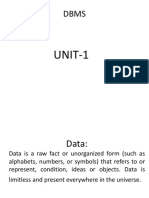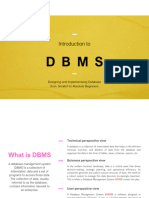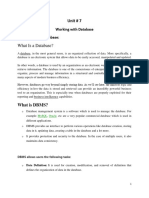What Is A Database Management System (DBMS) - Definition From Techopedia
Uploaded by
sherakram496What Is A Database Management System (DBMS) - Definition From Techopedia
Uploaded by
sherakram496Database Management System (DBMS)
Definition - What does Database Management System (DBMS) mean?
A database management system (DBMS) is a software package designed to define, manipulate, retrieve and manage data in a database. A DBMS generally manipulates the data itself, the data format, field names, record structure and file structure. It also defines rules to validate and manipulate this data. A DBMS relieves users of framing programs for data maintenance. Fourthgeneration query languages, such as SQL, are used along with the DBMS package to interact with a database.
T echopedia explains Database Management System (DBMS)
A database is the back-end of an application. A DBMS receives instruction from a DBA and accordingly instructs the system to make the necessary changes. These commands can be to load, retrieve or modify existing data from the system. A DBMS always provides data independence. Any change in storage mechanism and formats are performed without modifying the entire application . There are four main types of database organization: Relational Database: Data is organized as logically independent tables. Relationships among tables are shown through shared data. The data in one table may reference similar data in other tables, which maintains the integrity of the links among them. This feature is referred to as referential integrity - an important concept in a relational database system. Operations such as select and join can be performed on these tables. This is the most widely used system of database organization. Flat Database: Data is organized in a single kind of record with a fixed number of fields. This database type encounters more errors due to the repetitive nature of data. Object Oriented Database: Data is organized with similarity to object oriented programming concepts. An object consists of data and methods, while classes group objects having similar data and methods. Hierarchical Database: Data is organized with hierarchical relationships. It becomes a complex network if the one-to-many relationship is violated.
Posted by: Cory Janssen (/contributors/cory-janssen)
You might also like
- Introduction To Database Management SystemNo ratings yetIntroduction To Database Management System2 pages
- INTRODUCTION - 15.02.2023 To 17.02.2023No ratings yetINTRODUCTION - 15.02.2023 To 17.02.202346 pages
- Database Management System: This Article Has Multiple Issues. Please HelpNo ratings yetDatabase Management System: This Article Has Multiple Issues. Please Help11 pages
- Database: An Example of Output From An SQL Database QueryNo ratings yetDatabase: An Example of Output From An SQL Database Query18 pages
- Introduction To Database:: Schedule A Mock Interview at WWW - Eguru.oooNo ratings yetIntroduction To Database:: Schedule A Mock Interview at WWW - Eguru.ooo29 pages
- Important DBMS Questions For Final Exam: GgisolutionsNo ratings yetImportant DBMS Questions For Final Exam: Ggisolutions12 pages
- Imperia+++++++L Leadership School Course Outlines100% (1)Imperia+++++++L Leadership School Course Outlines25 pages
- What Is DBMS, Advantages and ApplicationsNo ratings yetWhat Is DBMS, Advantages and Applications7 pages
- Database Management System: 01 02 Evolution of Database DBMS DefinedNo ratings yetDatabase Management System: 01 02 Evolution of Database DBMS Defined30 pages
- 61bdbf4846c3f - Database Management System 2078No ratings yet61bdbf4846c3f - Database Management System 20789 pages
- INTRODUCTION TO DATABASE MANAGEMENT SYSTEMS SUMMARY NOTESNo ratings yetINTRODUCTION TO DATABASE MANAGEMENT SYSTEMS SUMMARY NOTES10 pages
- Chapter 3 - Database Systems, Data Warehouses, and Data MartsNo ratings yetChapter 3 - Database Systems, Data Warehouses, and Data Marts5 pages
- THE SQL LANGUAGE: Master Database Management and Unlock the Power of Data (2024 Beginner's Guide)From EverandTHE SQL LANGUAGE: Master Database Management and Unlock the Power of Data (2024 Beginner's Guide)No ratings yet



























































